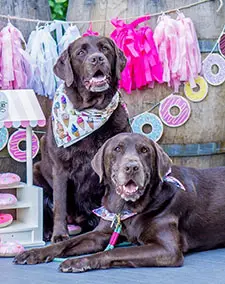Has your dog developed an itchy sore on their head, tail, or leg? There’s a chance your dog might have a hot spot.
Hot spots are wet, oozy skin lesions that your dog can’t stop licking or scratching. They can spread very quickly so if you find one on your dog, you should take care of it right away.
The best way to treat a hot spot on your labrador, or any dog, is to catch it early, keep it dry and prevent your dog from licking or scratching the spot. With quick at-home treatment, you might be able to avoid visiting the vet.
When Lucy got her first hot spot I had no clue what it was! None of my previous labs had this problem.
I had years of experience caring for dogs, so I knew a lot of small irritations go away on their own. But that wasn’t the case with Lucy’s first hot spot or many she’s had every summer since.
Since Lucy’s first hot spot spread so quickly and was so severe, I got used to taking her to the vet at the first sign of a new spot. Lucy tends to get these sores (also known as atopic dermatitis) in mid to late summer when she’s swimming multiple times a day or has been in an area with many insects or sand that gets under her fur.
After all of those summer vet visits, I’ve built up a lot of experience and knowledge about hot spots on dogs and how to treat them.
I’ve also collected a well-stocked first aid kit to treat hot spots. These experiences and home remedies have saved us from the need to visit the vet for hot spots since 2019.
*This post contains affiliate links. When you click my links and shop for items I recommend, I may earn a small commission that helps me operate my blog. Thank you in advance!

What is a Hot Spot on a Dog?
Hot spot is the common term for a wet, oozy skin lesion that occurs on some dogs.
According to the VCA, “canine hot spots are red, inflamed skin lesions also known as pyotraumatic dermatitis or acute moist dermatitis.”
When a hot spot starts to form, it might look like a red scrape or pimple. As your dog licks or scratches, it will grow in size and begin to look like a wet and seepy wound.
When a hot spot heals, it will form a thick scab over the skin that looks like dinosaur skin (my very non-medical term!).
In most cases, you should leave the scab untouched once it forms. Resist the urge to pick at it because you could “restart” the hot spot.
Hot spots are not always infected, but if not treated right away they could become infected.
A few years ago Lucy had a hot spot that I was confident I could treat at home, but it would not go away.
On our morning walk, we ran into our vet on the sidewalk. She looked at the spot and immediately noticed inflammation and infection under the skin. Lucy did a round of antibiotics and a topical treatment to help the hot spot and underlying bacterial infection heal.

If you notice inflammation under or around your dog’s hot spot, you may want to see your vet. Also, if your dog has a hot spot that you’re self-treating but it isn’t starting to scab over within a couple of days, I would call your vet.
What Can Cause a Hot Spot on My Labrador?
Many dogs will never have a hot spot in their lives. My dog Lucy is the only dog in our family who gets them (out of 7 dogs!). She only gets hot spots in the Summer, usually after swimming and being wet for a prolonged time.
Generally, a hot spot will start with some kind of skin irritation such as:
- Insect, flea, or tick bite
- Dirt or sand embedded in the fur
- A small scratch that gets itchy
- Food allergies
- Ear infection
- Compulsive licking due to stress or anxiety
Whatever the initial irritation is, from there it’s constant itching, obsessive licking, or chewing that causes the “acute moist dermatitis” to develop.
This is why it’s so important to inspect your dog’s body on a daily basis and jump into action when you find a skin irritation that could become a hot spot. It’s easier to prevent a hot spot than it is to treat them.
If you’re spending time outdoors or in the woods with your dog, make sure they’re on a flea and tick preventative. You can also spray them (and yourself) with a natural flea and tick repellant such as Wondercide.

Are Labradors more prone to hot spots?
There’s no medical data that suggests Labradors are more prone to hot spots. However, dog breeds with a thick coat and love of water can create the perfect conditions for a hot spot to form. That includes Labradors, Golden Retrievers, Newfoundlands, German Shephards, and more.
My chocolate labrador Lucy typically gets hotspots on her head or around her neck where her collar hits.
A few summers ago we were at a beach vacation house with a pool. Lucy was in the ocean and the pool non-stop every day! Such a lab!
Since we were in a new-to-us town I kept her collar and tags on all day just in case she escaped the yard.
Since she is prone to hot spots, I was so careful to dry her off every chance I got and to swap out her collar for dry ones. But she ended up getting a hot spot on the last day and I had to make a special visit to Olde Towne Animal Hospital.
This veterinarian was really great (more on his unique treatment below!)
One thing he said that stuck with me is that Lucy’s collar holds her neck folds together! Even though I was careful about putting on a dry collar, it was still holding together her skin to make a nice warm and wet spot for the hot spot to form.
Sure enough, Lucy gets most of the hot spots on her neck where the collar rubs or where her collar holds her neck folds together. One way to prevent this is to take her collar off as much as possible.
Lucy is microchipped and well trained to stay near me and come when I call, so I feel comfortable doing this.
But she still gets hot spots every Summer! Now I’m just better at catching them early and treating them.

How to Treat Your Labrador’s Hot Spots
The best hot spot treatment is to catch it early, keep it dry and prevent your dog from scratching or licking it.
When I first notice a hot spot it might be because Lucy is scratching a spot or I’m petting her and feel it.
The affected area will feel kinda wet and raised. I immediately pull out the clippers (I use these from Wahl) and trim the area. Trimming fur around the hot spot is an important first step to get air on the spot and help it dry out.
Once the spot is trimmed, I clean it with an antiseptic wash to prevent skin infections.
I got a skin cleaner called Hibiclens from a vet a couple of years go and it’s great. You can find this at most pharmacies or on Amazon.
First steps to treat a hot spot at home:
- Carefully trim the fur around the affected areas (I use these clippers)
- Wash the area with an antiseptic wash (ask your vet or get something like this)
- Dry the area
- If needed, use an e-collar or inflatable collar to prevent your dog from scratching or licking the spot
I mentioned earlier in this post that a few Summers ago we had to go to the vet while on vacation at the beach. The veterinarian at Old Towne Animal Hospital was wonderful and told me he sees a lot of hot spots (especially on labradors) since dogs at the beach are always swimming.
He inspected Lucy and immediately trimmed the fur to get air on the hot spot and also get a clear view of how the spot had spread.
After washing the area with an antiseptic wash, he did something that no other vet has done to treat Lucy’s hot spots: he injected the area with cortisone.
He explained to me that he likes to reduce the itchiness immediately since it’s scratching that causes the hot spot to spread.
The cortisone shot almost immediately relieved a lot of the pain Lucy was feeling and took down the redness of the area. This was such a thoughtful and efficient treatment and I was so thankful to this vet!
Next, he gave me a bottle of GentaSpray (it’s prescription only) with instructions to spray the hot spot every 12 hours until it goes away or 7-10 days.
This spray is very efficient at healing Lucy’s hot spots! If you take your dog to the vet for skin conditions like chronic hot spots, inquire if this is available and would help your pup. Then, remember to take the bottle with you on any dog-friendly vacations so you’re prepared!

What’s in My Hot Spot First Aid Kit?
What works well to treat hot spots at home? I’ve had years of hot spot experience to put together a first aid kit to treat these sores at home.
Since quick action helps prevent hot spots from growing, it’s important to have these supplies at home.
If you notice a spot on the weekend, you might not be able to get to the vet right away. It’s better to be prepared and do something than wait and have it get worse.
Here’s what I have in my hot spot home remedies kit:
- Wahl Clippers (available here and here)
- Hibiclens Antiseptic Cleanser
- GentaSpray (requires a veterinarian’s prescription)
- Neo-Predef powder (requires a veterinarian’s prescription)
- CBD Hot Spot Balm from Kitsie
- Silver Honey Hot Spot + Wound Antimicrobial Ointment
- Hot Spot Relief Spritz from Earth Bath
With my stash of supplies at home, I’ve been able to treat Lucy’s hot spots without any vet visits for two Summers. If a spot were to become inflamed or wouldn’t begin to heal after a few days, I would make a vet appointment.
Like I said before, it’s easier to prevent a hot spot than it is to treat them. So let’s talk about prevent hot spots on dogs!
How do I prevent my dog from getting hot spots in the future?
If you’ve made it this far in the blog post, then you probably have a good idea of how to prevent hot spots on dogs.
After your dog goes swimming, gets bathed or gets wet in the rain, you should dry them off as soon as possible. With my labrador’s thick fur, I focus on thoroughly drying the neck and ears.
After outdoor activities or swimming, you should inspect your dog’s body to look for ticks, scrapes, burrs or anything else that could turn into something your dog itches or causes excessive licking.
You can do this by simply petting your dog, paying special attention to areas where their fur is really thick.
While you’re inspecting your dog, you might as well brush them, too. Regular grooming can help prevent hot spots.
If you notice your dog scratching or licking a particular spot on their body excessively, get a closer look.
You might consider cleaning it with an unscented dog wipe or giving it a spitz of the Earth Bath spray I recommend above. This spritz has tea tree oil and aloe vera so it will soothe the itch before it turns into a hot spot.
While hot spots can occur anywhere on your lab’s body, Lucy is prone to hot spots around her neck and collar area. So I clean our collars on a regular basis. I prefer to handwash our collars, you can get a tutorial on that in this post.
Did you find this post helpful? Consider sharing it with a friend or saving it to Pinterest!
While you’re here, check out these posts:
Healthy Kong Stuffing Recipes my Labradors Love
Podcast Episode 62: Dr. Judy Morgan of Naturally Healthy Pets
What to Ask Your Vet with Your Dog is In Pain?
How to Save Money on Your Dog’s Medication





0 Comments